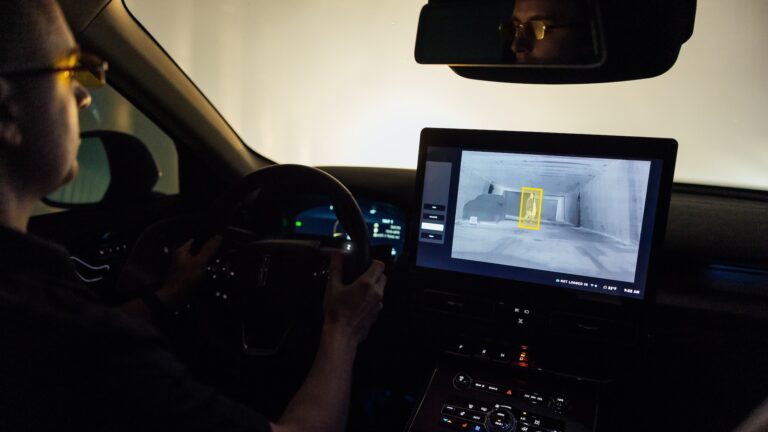The number of pedestrian deaths in vehicles increased by 19% between 2019 and 2022. And according to AAA, three-quarters of all pedestrian deaths occur after dark. Automotive technology supplier Magna is actively trying to change that, with thermal technology installed on 1.2 million vehicles and that number continues to rise.
Originally called “Night Vision” and introduced on the 2005 BMW 7 Series, Magna’s thermal sensing product sees the road ahead up to four times further than typical headlights can see. Currently available on 40 different vehicle models from 13 manufacturers including Bentley, BMW, Audi, Volkswagen, Porsche and examples from Stellantis (Dodge, Fiat, Ram, Peugeot, Jeep, and more) and GM, the technology was created to reduce pedestrian and cyclist fatalities.
This is how it works.
“Eyes” that see the road ahead using thermal detection
The microbolometer, or uncooled thermal sensor, was invented in the late 1970s by the military. The U.S. government declassified the technology after the 1991 Gulf War, and the use of thermal imaging was introduced to municipal fire departments to help firefighters see through smoke. Before that, first responders had to rely on the slow process of cleaning each room individually by touch and visual cues.
In the security field, thermal imaging cameras are becoming increasingly popular. Airports use them for perimeter defense, and during the SARS outbreak of 2002-2004, they used them to measure passengers’ temperatures.
The latest generation of Magna technology provides better road coverage, enhanced detection capabilities and a clearer image for drivers through fog, smoke (a key factor for those affected by wildfires), snow squalls or in total darkness. Because thermal imaging cameras don’t “see” visible light, the system isn’t affected by oncoming headlights or sun glare, Magna says. With distracted driving becoming a growing problem, automakers and technology companies like Magna are actively looking for solutions.
“Even during the day, there are times when smoke or fog can be difficult to see,” says Richard Seoane, Magna’s vice president of operations and business development for thermal products. “Divers heading toward the smoke may think it’s only a short distance away, but it’s actually a mile away. That was the case in California two years ago, when fog caused a 90-car pileup.”
How Magna works
An infrared video camera is mounted on the front of the vehicle and detects temperature differences of less than 1/10th of a degree to create a highly detailed thermal image of the road scene. Using convolutional neural networks, the software creates three-dimensional data for image classification and object recognition tasks.
The algorithm is then trained to classify these objects in the image field, including pedestrians, buses, motorcycles, etc. Seaone explains that the system predicts the movement vector, which helps the driver in many ways. For example, pedestrians don’t move quickly, but animals and bicycles do. Knowing this information helps driver assistance programs adapt and adjust to avoid an accident.
“Our algorithms detect animals, pedestrians and cyclists more than 100 meters in front of the vehicle to alert drivers of such dangers,” Seoane says. He explains that the algorithms can run in a car’s dedicated ECU (electronic control unit) or be hosted by a manufacturer’s central computer unit.
While the human eye can’t detect the infrared spectrum, thermal sensing systems can. By detecting very small differences in temperature, the technology can tell the difference between a mailbox, a deer or a human, Magna explains.
Early versions of thermal-sensing systems were too big to fit in a trunk. Today, Magna’s camera is quite small (about the size of a golf ball) and it’s about to get even smaller. The company’s next-generation thermal-sensing technology is set to launch next year and will also feature an increased 360-degree viewing range. That means better all-around visibility, even in the dark, helping to address backing-up accidents that mostly happen with children or small pets. It’s also expected to detect information up to three football fields away, increasing stopping time and potentially saving more lives.


